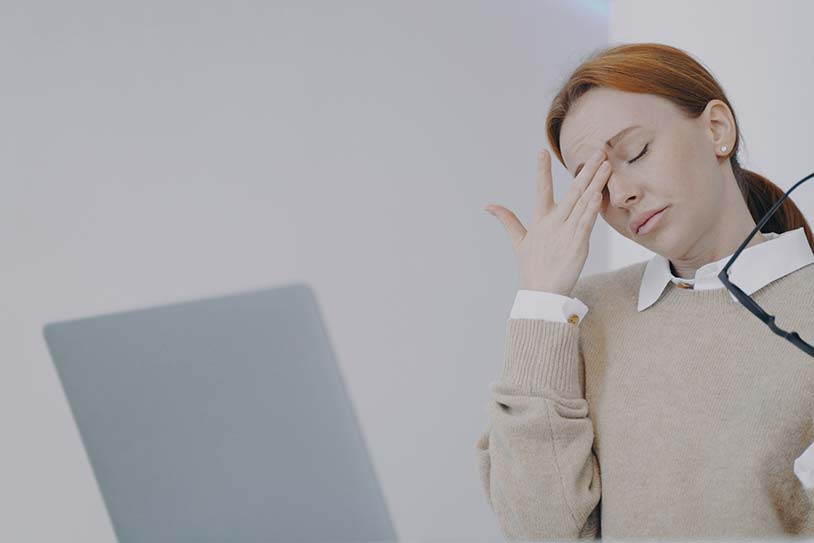
Remote meetings, open-office chatter, blurred home boundaries, many of us have traded one set of stressors for another. Video-call exhaustion (often called “Zoom fatigue”) and the slow burnout that builds in office settings can feel like opposite problems, but they share the same fuel: chronic mental load, unclear boundaries, and a daily rhythm that erodes our energy. At Stenzel Clinical, we help people restore balance with realistic, evidence-based steps that fit real lives. Below are six concrete steps you can take today to move from fatigue and burnout toward a sustainable work–life balance.
What’s going on: Zoom fatigue vs. office burnout (briefly)
Zoom fatigue is the heavy, tired feeling after many video calls: drained attention, sore necks, irritability, and a sense that you’re “on” all the time. Researchers and behavioral scientists have identified several reasons for this: extra cognitive load from reading facial cues on screen, the awkward gaze and camera constraints, and the temptation to multitask during meetings. Simple, research-backed changes can reduce that burden.
Burnout, especially workplace or occupational burnout, is a longer, deeper process. The World Health Organization and workplace studies describe burnout as a state defined by emotional exhaustion, cynicism or detachment from work, and reduced professional efficacy. Burnout builds when stress is prolonged, and you don’t have sufficient recovery or control over demands. It often looks like chronic fatigue, distancing from colleagues or job tasks, and difficulty functioning at previous levels. Tackling burnout often requires changes to workload, culture, and the way you care for yourself.
Both problems reduce your life quality. The good news: many practical actions are proven to help, and you don’t need to overhaul your job overnight. Below are six steps you can take both for individuals and for teams to reclaim a healthier balance.
Step 1: Audit and prioritize your attention (protect your cognitive energy)
Your attention is finite. Each decision, each meeting, each choice you make uses a little of that finite pool. Start by tracking a typical workday for two or three days: note meetings, task-switches, decision-heavy moments, and when you feel drained. This isn’t about judgment it’s information you can use.
Actionable moves:
- Block “deep work” time on your calendar for high-focus tasks and treat it as nonnegotiable.
- Batch quick, similar tasks (email, quick calls) into single blocks so you reduce switching costs.
- Use simple decision rules for low-stakes choices (e.g., one-week meal rotation) to save decision energy for bigger items.
Research shows avoiding multitasking and reducing unnecessary meetings noticeably lessens video-call fatigue and improves concentration. When you conserve attention, every other step becomes easier.
Step 2: Reclaim meeting time: fewer, shorter, smarter
Meetings are the single biggest drain many people report. Not every meeting needs video not every conversation needs one at all.
What to change today:
- Ask for an agenda before accepting a meeting. If none is provided, request one or suggest an alternative (email summary, shared doc).
- Propose shorter meetings (25–30 minutes) instead of defaulting to 60. Shorter meetings force focus and decisions.
- Make video optional for check-ins and smaller conversations; use audio or chat when visual cues aren’t necessary.
- Insist on meeting-free blocks (for you and the team) even two hours of guaranteed focus time each afternoon reduces fatigue.
Harvard Business Review and other experts recommend these simple meeting shifts because they lower cognitive strain from back-to-back calls and help preserve energy for creative work. Teams who adopt meeting hygiene usually see productivity and morale improve.
Step 3: Microbreaks, transitions, and real unplugging
Fatigue compounds when you jump from one meeting to another without pause. Your brain needs short recovery moments to reset.
Practical habits:
- Schedule a 5–10 minute “buffer” between meetings. Use it to stand, stretch, hydrate, or breathe. Treat buffer time like a meeting you cannot cancel.
- Create a consistent ritual for ending work: shut the laptop, clear the desk, take a short walk, or do a 5-minute breathing practice. Rituals tell your nervous system the workday is over.
- Use a physical boundary even a dedicated chair or a closed door to separate work space from living space if you work at home.
Stenzel Clinical’s counselors emphasize the power of intentional breaks to restore efficiency and reduce mental exhaustion. Studies show regular interruptions for short breaks reduce overall fatigue and restore performance more than trying to “power through.”

Step 4: Build better boundaries and communicate them clearly
Boundaries are how you protect your time and energy. They’re also how you train colleagues and yourself about what’s reasonable.
How to set boundaries that stick:
- Make your working hours visible (calendar, email auto-responder). If you’re hybrid, note your in-office and remote days so teammates know when you’re available.
- Say “no” or “not now” with alternatives. If a task or meeting conflicts, offer a different time or delegate. Learning to say no kindly is a skill, not a failure.
- Use technology controls: do-not-disturb on chat after hours, separate work and personal apps on your phone, or a dedicated notification schedule.
When organizations model healthy boundaries and leaders respect them, burnout rates fall. If your workplace resists boundaries, document the effects on your work and wellbeing and consider involving leadership or HR meaningful change often requires a cultural shift.
Step 5: Rebuild recovery routines: sleep, movement, meaning
You can’t out-plan your way out of chronic stress if you don’t prioritize recovery. Sleep, movement, social connection, and activities that give you meaning are non-negotiable.
Daily recovery checklist:
- Prioritize sleep: aim for consistent bed and wake times and wind down without screens 30–60 minutes before bed.
- Move daily: even a 20-minute walk raises mood and reduces stress chemistry.
- Reconnect to meaning schedule time for relationships, hobbies, and activities that remind you are more than your job.
- Use a weekly reset: a short planning session each Sunday to align work tasks with personal priorities reduces decision stress during the week.
When we help clients combat burnout, we always look at these foundational habits because physical recovery supports mental recovery. Sustained changes here reduce emotional exhaustion and increase resilience.
Step 6: Ask for help early: coaching, therapy, and organizational solutions
Burnout and chronic exhaustion don’t always resolve with better time management alone. When feelings of cynicism, detachment, or persistent low energy take hold, reaching out for professional help is a wise and effective step.
Options that help:
- Short-term coaching or counseling can build coping skills (stress management, boundary-setting, communication) and help you design practical changes that stick.
- Workplace interventions job redesign, clearer role expectations, workload review are sometimes necessary. If your organization can’t or won’t change, a clinician can help you evaluate options and plan next steps.
- If symptoms like persistent hopelessness, sleep disruption, or trouble functioning appear, seek a licensed mental health provider. Burnout can overlap with depression and deserves clinical attention.
At Stenzel Clinical, we offer in-person and online counseling to help people reclaim balance and rebuild a life that fits them. Early help prevents small problems from becoming large ones. If you or a team member are struggling, connecting with professional support is a strength, not a sign of failure.
Leadership matters: what managers can do
If you lead a team, you set the tone. Burnout isn’t just personal it’s systemic. Leaders can reduce both Zoom fatigue and office burnout with a few concrete moves we recommend to organizations:
- Model boundaries: use offline hours and don’t expect immediate after-hours responses.
- Reduce meeting density: consolidate decision-making and delegate effectively.
- Monitor workload and ask employees how they’re doing then act on what you learn.
- Provide access to mental health resources and normalize their use.
Organizations that adjust culture and workload see improved retention, engagement, and output. When leaders act, everyone benefits.
Quick, practical templates you can use now
- Meeting RSVP reply: “Thanks could you share a 1–2 line agenda? If this is a status update, I can send notes instead.”
- Boundary message: “I’m offline after 6 p.m. urgent items please text; I’ll respond next business day.”
- Short daily ritual: “At 4:45 p.m., I’ll close my laptop, list tomorrow’s top 3 tasks, and take a 10-minute walk.”
Small scripts make big behavior changes easier because they remove the friction of figuring out what to say in the moment.
When to seek clinical help right away
If you notice persistent changes like:
- Prolonged inability to get restful sleep,
- Loss of interest in previously valued activities,
- Thoughts about harming yourself, or
- Marked decrease in work or home functioning,
please reach out to a licensed clinician or emergency services immediately. Burnout and depression overlap; timely professional care is essential when symptoms are severe.
Stenzel Clinical has a team of licensed clinicians offering online and in-person care in Illinois. If you’d like support tailored to your situation, we’re available to walk with you through recovery and practical change.
Putting it together: a 30-day plan
Try this simple plan to begin reclaiming balance:
- Week 1: Audit your calendar and block three 60–90 minute deep-work periods across the week. Add 5-minute buffers between meetings.
- Week 2: Cut nonessential meetings by 25% (delegate, shorten, or cancel). Start a 10-minute daily wind-down ritual.
- Week 3: Implement at least two boundary scripts (work hours and meeting agenda requests). Prioritize 3 nights of solid sleep.
- Week 4: Book a single session with a coach or counselor to review progress and plan next steps.
If you follow this plan and feel no improvement, or if symptoms worsen, reach out for professional care earlier.
Final thoughts from Stenzel Clinical
Moving from Zoom fatigue to office burnout or addressing both at once is not about perfection. It’s about consistent choices that protect your attention, restore your energy, and let you reconnect to things that matter. Start with a single change: shorten a meeting, take a microbreak, set one boundary, or ask for support. Those small moves compound into big improvements.
We’re here to help. If you want practical counseling, short-term coaching, or a conversation about workplace strategies, Stenzel Clinical offers both in-person and secure online options. You don’t have to do this alone.
“Zoom fatigue is the heavy, tired feeling after many video calls: drained attention, sore necks, irritability, and a sense that you’re “on” all the time.
Stenzel Clinical Services
Recent Posts
Overcoming Limiting Beliefs
I found that much of our suffering originates from an invisible source: limiting beliefs. These are deeply held assumptions about [...]
Fueling Optimism
Can you feel it? Just picturing a positive future moment say, an exciting vacation or an anticipated event can instantly [...]
7 Evidence-Based Steps to Manage Panic Attacks at Home
A panic attack can feel terrifying: your heart races, your breathing speeds up, your hands tremble, and your brain [...]



